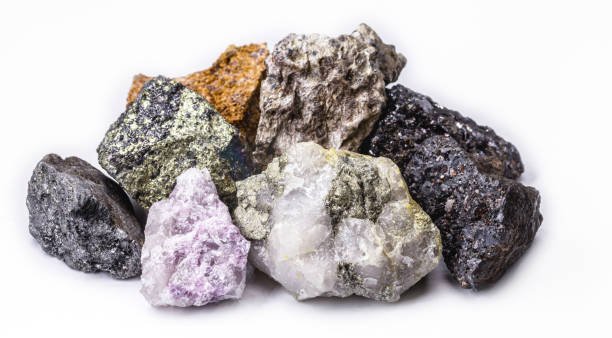Latest News
Nickel: The Rising Star in the Commodity Market at 5StarStocks.com

In an era where the push for sustainable energy solutions and electric vehicles (EVs) is gaining momentum, nickel has emerged as a pivotal commodity. Investors are increasingly looking to nickel not only for its industrial applications but also for its potential as a valuable investment. This article will explore the significance of nickel in today’s market, its various applications, the dynamics of supply and demand, and investment opportunities, especially through platforms like 5StarStocks.com.
What is Nickel?
Nickel is a silvery-white metal known for its strength, resistance to corrosion, and ability to withstand high temperatures. It is primarily mined from two types of ores: laterite and sulfide. Nickel’s unique properties make it an essential component in various industries, particularly in the manufacturing of stainless steel and batteries.
Brief History of Nickel
Nickel’s usage dates back to ancient times, but its industrial significance began to grow in the late 19th century with the advent of stainless steel. Over the years, nickel has become integral in numerous applications, particularly as the world moves towards electrification and green technologies.
The Importance of Nickel in Modern Industries
1. Stainless Steel Production
Nickel is a critical alloying element in stainless steel, contributing to its corrosion resistance and strength. Approximately 70% of the world’s nickel supply is used in the production of stainless steel. The construction, automotive, and aerospace industries heavily rely on stainless steel for its durability and resistance to rust.
2. Electric Vehicle Batteries
The rapid growth of the electric vehicle market has significantly increased the demand for nickel. Nickel is a vital component in lithium-ion batteries, specifically in the cathode, which determines the battery’s performance and energy density. As automakers pivot towards EVs, the demand for high-nickel battery chemistries, such as nickel-cobalt-manganese (NCM), is on the rise.
3. Energy Storage Solutions
In addition to electric vehicles, nickel is essential in energy storage systems, particularly in the renewable energy sector. As the world transitions to cleaner energy, the demand for efficient battery storage solutions continues to grow, further boosting nickel consumption.
4. Alloys and Specialty Products
Nickel is also utilized in various alloys, which are vital in industries that require materials to withstand extreme conditions. Superalloys, which contain nickel, are employed in aerospace applications, gas turbines, and chemical processing.
5. Plating and Coatings
Nickel plating is widely used in the automotive and electronics industries for its corrosion resistance and aesthetic appeal. It is often used to coat metal parts, improving their durability and lifespan.
The Dynamics of the Nickel Market
Supply and Demand Factors
Understanding the dynamics of supply and demand is essential for evaluating investment opportunities in nickel. Several factors influence these dynamics:
Global Production
The largest producers of nickel include Indonesia, the Philippines, Russia, and Canada. Indonesia has emerged as a dominant player, particularly with the rise of nickel laterite mining. Fluctuations in production due to geopolitical tensions, regulatory changes, or environmental concerns can significantly impact the global nickel supply.
Demand Drivers
The primary demand drivers for nickel are:
- Electric Vehicles: As more consumers and governments prioritize electric mobility, the demand for nickel in EV batteries is expected to surge.
- Infrastructure Projects: Major infrastructure developments worldwide require stainless steel, thus driving nickel demand.
- Technological Innovations: Advancements in battery technology that favor high-nickel chemistries will continue to boost demand.
Price Volatility
Nickel prices are characterized by volatility, influenced by several factors:
- Market Speculation: Like other commodities, nickel prices can be affected by speculative trading, leading to significant price swings.
- Geopolitical Issues: Political instability in major nickel-producing regions can disrupt supply chains, affecting prices.
- Economic Conditions: Global economic growth rates and industrial production levels significantly impact nickel demand and pricing.
Investment Opportunities in Nickel
Investing in nickel offers various opportunities, particularly as the demand for the metal grows. Here’s how investors can explore nickel investments effectively through 5StarStocks.com.
1. Nickel Mining Stocks
Investing in mining companies provides direct exposure to nickel price fluctuations. Some notable companies include:
- Vale S.A.: One of the world’s largest nickel producers, with operations in Canada, Brazil, and Indonesia.
- Norilsk Nickel: A major player in the global nickel market, based in Russia.
- BHP Group: An Australian multinational mining company with significant nickel assets.
Analyzing Mining Stocks
5StarStocks.com offers in-depth analysis and recommendations for investors interested in nickel mining stocks. Key metrics to consider include:
- Production Costs: Understanding a company’s cost structure can help evaluate its profitability in different market conditions.
- Geographic Diversification: Companies with diversified operations are often better positioned to weather supply disruptions.
- Sustainability Practices: As environmental concerns rise, companies prioritizing sustainable practices may become more attractive to investors.
2. Exchange-Traded Funds (ETFs)
ETFs provide a way to invest in nickel without the risks associated with individual stocks. They typically include a basket of mining stocks or may focus on nickel futures. Some notable nickel ETFs include:
- Global X Lithium & Battery Tech ETF (LIT): While primarily focused on lithium, it includes exposure to nickel mining companies.
- iPath Series B Bloomberg Nickel Subindex Total Return ETN (JJN): This ETN tracks the performance of nickel futures and provides direct exposure to nickel prices.
3. Physical Nickel Investments
Investing in physical nickel, although less common, is another option. This approach requires secure storage and insurance but can serve as a hedge against inflation and market volatility.
4. Renewable Energy Stocks
Companies involved in renewable energy technologies that utilize nickel in their batteries represent another investment avenue. With the global shift towards sustainability, these companies are likely to experience significant growth.
5. Nickel Futures
For more sophisticated investors, trading nickel futures can be a way to profit from price fluctuations. Futures trading requires a solid understanding of market dynamics and should be approached with caution.
Analyzing Nickel Investments with 5StarStocks.com
Comprehensive Market Research
5StarStocks.com offers extensive market research and analysis on nickel and its related sectors. Investors can access detailed reports on price trends, market forecasts, and key developments that may impact nickel investments.
Expert Recommendations
The platform provides expert stock recommendations based on thorough analysis. Investors can benefit from insights into the best-performing nickel stocks and ETFs, helping them make informed decisions.
Educational Resources
5StarStocks.com also emphasizes education, offering articles, webinars, and tutorials to help investors understand the nickel market and make informed investment choices. Knowledge about market dynamics, technical analysis, and fundamental analysis is crucial for successful investing.
Portfolio Tracking Tools
For investors managing multiple assets, 5StarStocks.com provides portfolio tracking tools to monitor performance. These tools can help investors assess their exposure to nickel and make adjustments as needed.
The Future of Nickel
Continued Growth in Electric Vehicles
As electric vehicles become mainstream, the demand for nickel is expected to rise sharply. Major automotive manufacturers are committing to EV production, and governments worldwide are promoting sustainable transport. This trend is likely to create a long-term demand for nickel, making it a crucial component in the transition to green technologies.
Innovations in Battery Technology
Ongoing research in battery technology is likely to focus on improving the energy density and reducing costs. As high-nickel batteries gain traction, manufacturers will increasingly seek nickel to meet performance requirements.
Sustainability Initiatives
The nickel industry faces growing pressure to adopt sustainable practices. Companies that prioritize eco-friendly mining and processing techniques are likely to gain favor among investors. The shift towards sustainability could redefine the nickel market landscape.
Geopolitical Considerations
Geopolitical factors will continue to impact the nickel market. Investors should stay informed about political developments in major producing regions, as these can significantly influence supply chains and pricing.
Conclusion
Nickel is set to play a crucial role in the future of energy, driven by the surge in electric vehicles and the demand for renewable energy storage solutions. With various investment opportunities available, including mining stocks, ETFs, and physical nickel, investors can capitalize on this growing market. Platforms like 5StarStocks.com provide valuable resources and insights, making it easier for investors to navigate the complexities of the nickel market. As the world continues to shift toward sustainability and electrification, nickel’s importance will only grow, making it an attractive investment for those looking to the future.
Frequently Asked Questions
1. Why is nickel essential for electric vehicles?
Nickel is a critical component in lithium-ion batteries, enhancing energy density and performance, which is vital for electric vehicle efficiency.
2. What are the main factors affecting nickel prices?
Nickel prices are influenced by supply and demand dynamics, geopolitical issues, market speculation, and global economic conditions.
3. How can I invest in nickel?
You can invest in nickel through mining stocks, ETFs, physical nickel, or companies focused on renewable energy solutions.
4. What resources does 5StarStocks.com offer for nickel investors?
5StarStocks.com provides market research, expert stock recommendations, educational resources, and portfolio tracking tools for investors in the nickel market.
5. What is the future outlook for nickel demand?
Nickel demand is expected to grow, primarily driven by the electric vehicle market, technological advancements in battery chemistry, and increasing focus on sustainability.
Latest News
What to Do When Your Daylily Stalk Breaks in a Transport Bag: A Practical Guide

Daylilies are beloved by gardeners for their vibrant flowers, hardiness, and relatively low maintenance. Whether you’re transporting daylilies from a nursery or relocating them in your own garden, accidents can happen—one of the most common being a broken stalk during transport. This can be frustrating, especially if the plant is in full bloom or about to flower. However, a broken stalk isn’t necessarily the end for your plant. With a few steps and precautions, you can salvage your daylily and ensure that it thrives despite the damage.
In this article, we’ll discuss how to handle a broken daylily stalk during transport, what steps to take to promote healing, and how to prevent such accidents in the future.
Understanding Daylilies and Their Growth
Before diving into the solutions, it’s helpful to understand the growth structure of daylilies. Daylilies (Hemerocallis) are herbaceous perennials, meaning they grow from fleshy, underground roots and produce foliage and flower stalks above ground. The stalk, also known as a scape, is where the flowers bloom. Unlike many other plants, daylilies are quite resilient, and even if a scape is damaged or broken, the root system remains intact and can continue to produce healthy growth.
Daylilies are known for their ability to bounce back from stress. While a broken stalk may mean you lose the current flowers or buds, the plant itself can recover and bloom again next season.
Step-by-Step Guide: What to Do When a Daylily Stalk Breaks in a Transport Bag
If you notice a broken stalk while unpacking your daylilies, don’t panic. Here’s what you should do:
1. Assess the Damage
The first step is to carefully examine the broken stalk. Is it completely severed or only partially damaged? If the break is clean, with no jagged edges, it might be possible to salvage part of the scape. On the other hand, if the break is severe and most of the stalk is destroyed, you may need to remove it entirely.
Tip: If the stalk has flower buds, it’s a good idea to remove them to reduce the plant’s energy expenditure on trying to support flowers from a weakened or damaged stem.
2. Remove the Broken Stalk
If the stalk is broken beyond repair, it’s best to remove it completely. Use sterilized garden shears or scissors to make a clean cut near the base of the stalk, being careful not to damage the surrounding leaves or foliage.
Cutting the damaged stalk allows the plant to redirect its energy to producing new growth rather than trying to heal a damaged scape. Additionally, removing the broken stalk reduces the risk of diseases, such as fungal infections, which can enter through the damaged tissue.
3. Provide Support for Partially Broken Stalks
If the stalk is only partially broken, you may be able to support it as it heals. Use plant ties or soft garden tape to gently secure the broken part of the stalk to a stake. Be careful not to wrap too tightly, as this can restrict growth and damage the plant further.
The goal is to support the stalk in an upright position so it can continue to receive nutrients while the break heals. Keep an eye on the stalk over the next few days, and if you notice any wilting or further deterioration, you may need to remove it entirely.
4. Water and Care for the Plant
After dealing with the broken stalk, it’s essential to care for the plant as a whole. Ensure that the daylily is planted in well-draining soil, as waterlogged roots can cause further stress. Water the plant thoroughly after planting or transporting, as this will help it recover from the shock.
Avoid fertilizing the plant immediately after transplanting or when it’s dealing with stress from a broken stalk. Too much fertilizer can overstimulate growth and cause more harm than good in the short term. Instead, focus on keeping the plant well-watered and protected from excessive heat or cold.
5. Monitor for New Growth
The good news is that daylilies are very resilient, and even if a stalk is broken, the plant will likely produce new growth. Monitor the plant for signs of fresh foliage or new scapes emerging from the base. This is a positive sign that the plant is recovering.
In many cases, daylilies will grow a new scape within the same growing season, although the new stalk may not produce as many flowers as the original one. In the following season, the plant should return to its full blooming potential.
Preventing Stalk Breaks in the Future
To avoid broken stalks during transport in the future, it’s important to take a few preventive measures:
1. Use a Sturdy Transport Bag
When transporting daylilies, ensure you use a strong, well-ventilated transport bag that provides adequate protection for the plant’s scapes and foliage. Avoid cramming multiple plants into a single bag, as this increases the risk of stalks getting bent or broken.
Tip: For added protection, you can wrap the stalks in soft materials like newspaper or bubble wrap before placing them in the transport bag.
2. Stake the Stalks Before Transport
If your daylily has particularly tall or delicate stalks, consider staking them before transport. A lightweight bamboo stake or similar support can help keep the scapes upright and prevent them from bending or breaking under their own weight.
3. Handle With Care
When loading and unloading daylilies, be gentle and avoid placing heavy items on top of the plants. Always carry them in an upright position, and if you’re transporting them in a vehicle, secure them to prevent tipping or sliding during the drive.
4. Transport During Cooler Hours
Heat stress can make plants more fragile, so try to transport your daylilies during the cooler parts of the day, such as early morning or late afternoon. This reduces the risk of the plant becoming stressed during transport, which can make it more prone to damage.
Can a Broken Daylily Stalk Affect Future Growth?
While a broken stalk may seem like a significant setback, it’s important to remember that daylilies are highly resilient. A broken scape won’t harm the plant’s root system or its ability to grow new leaves and stalks in the future.
The primary downside of a broken stalk is that you may lose any flowers or buds that were on it. However, the plant will continue to grow and should produce new scapes in the next blooming season.
In some cases, if the growing conditions are ideal and the plant is healthy, it may produce a secondary scape within the same season, allowing for another round of blooms.
Conclusion
While a broken daylily stalk during transport can be disappointing, it’s far from a death sentence for your plant. With proper care and attention, your daylily can recover from the damage and continue to thrive. By following the steps outlined in this guide, you can manage the damage, promote healing, and ensure that your daylily remains healthy for future growing seasons.
By taking preventive measures, such as using sturdy transport bags, staking the plants before transport, and handling them with care, you can reduce the risk of broken stalks in the future. With a little extra attention, your daylilies will continue to grace your garden with their beautiful blooms year after year.
7 Frequently Asked Questions (FAQs)
- Can a daylily still bloom after its stalk breaks?
- A broken stalk means you may lose the flowers or buds on that scape, but the plant itself can still grow new scapes and bloom in future seasons.
- Should I remove a broken daylily stalk?
- Yes, if the stalk is severely broken, it’s best to remove it to allow the plant to focus its energy on producing new growth.
- How do I support a partially broken stalk?
- Use plant ties or garden tape to secure the broken stalk to a stake, providing support while it heals.
- Will a broken stalk harm the root system of my daylily?
- No, a broken stalk won’t damage the root system. Daylilies are resilient and can recover from scape damage.
- Can daylilies grow a new stalk in the same season?
- Sometimes, depending on the plant’s health and growing conditions, a daylily may produce a new scape within the same season.
- How can I prevent daylily stalks from breaking during transport?
- Use a sturdy transport bag, stake the stalks beforehand, and handle the plants with care to minimize the risk of breakage.
- What should I do if the broken stalk has buds or flowers?
- Remove the buds or flowers from the damaged stalk to reduce the plant’s energy expenditure on trying to support them.
Latest News
Eonyoung Park and Momic: Exploring the Creative World Behind the Brand

Eonyoung Park is a name that has grown in recognition within the design and fashion industries. Known for her unique aesthetic and innovative designs, Park’s work has touched many aspects of creative arts, with a focus on minimalism and artistic expression. One of the most prominent aspects of her career is her involvement with Momic, a brand that has become synonymous with modern, minimalist design fused with cultural elements. In this article, we will explore Eonyoung Park’s journey, the philosophy behind Momic, and how her work has resonated with a global audience.
We will also dive into the essence of Momic, looking at how it reflects Park’s creative vision, its impact on the fashion industry, and why it has gained such a strong following. Whether you’re a fan of fashion, a student of design, or someone curious about the intersection of culture and creativity, this exploration into Eonyoung Park’s work and her brand will provide valuable insight.
Who is Eonyoung Park?
Eonyoung Park is a South Korean designer and creative director who has made waves in the international fashion scene. Her background in art and design gives her a unique edge, combining cultural elements with contemporary styles. She has become known for her minimalist approach, favoring clean lines, simple silhouettes, and understated elegance, which is reflected in the Momic brand.
Park’s career began in Seoul, where she studied design and honed her craft. Her early work was deeply rooted in Korean traditions, which she reinterpreted through modern lenses. Over time, she evolved into a designer who could balance traditional values with modern aesthetics, making her work globally appealing.
In her design philosophy, Park emphasizes sustainability, quality, and functionality, ensuring that her creations not only look good but also stand the test of time. This balance between beauty and practicality is one of the key reasons for her success.
Momic: The Intersection of Minimalism and Culture
Momic is the brand founded by Eonyoung Park, and it reflects her artistic vision perfectly. The name itself is derived from the fusion of “modern” and “minimalism,” two pillars that are essential to the brand’s ethos. Momic has quickly become a staple in the world of fashion and design for those who appreciate simple, elegant, and thoughtfully made products.
1. Design Philosophy
Momic’s designs are rooted in simplicity. The brand doesn’t rely on flashy trends or overly complex designs. Instead, it focuses on the essentials, allowing the wearer or user to enjoy the purity of design. The materials used are high-quality and sustainable, ensuring that every product reflects the brand’s commitment to longevity.
While minimalism is at the heart of Momic, it also integrates cultural influences, particularly from Korean traditions. These subtle nods to heritage make the brand stand out in a crowded market. Momic products often feature clean lines, neutral color palettes, and functional yet aesthetically pleasing forms.
2. Product Range
Momic started with clothing and accessories but has since expanded into various sectors of design, including home décor and lifestyle products. From sleek, minimalist furniture to simple yet elegant fashion pieces, every product under the Momic label reflects Eonyoung Park’s vision of modern minimalism.
The clothing line focuses on comfort and ease of wear while maintaining a high fashion appeal. This balance makes it popular with both everyday consumers and fashion-forward individuals. The home décor items, meanwhile, emphasize clean design that fits seamlessly into any modern living space.
3. Sustainability and Ethical Practices
A key element of Momic’s brand identity is its dedication to sustainability. In an age where fast fashion dominates, Park and her brand stand apart by prioritizing ethical manufacturing processes, sustainable materials, and long-lasting design. This focus on sustainability has made Momic popular with environmentally conscious consumers who are looking for brands that align with their values.
The Global Appeal of Momic
Momic’s minimalistic designs have transcended borders, appealing to a wide range of consumers across the world. Its simplicity, combined with subtle cultural elements, has made it popular in various fashion capitals, including New York, Paris, and Tokyo. But what exactly is it about Momic that resonates so deeply with people globally?
- Universal Aesthetic
Minimalism, as a design philosophy, has a universal appeal. It transcends cultural and geographical boundaries by focusing on simplicity, which many find attractive in a world that is often chaotic and overstimulating. - Functionality Meets Art
Momic’s designs are not only visually appealing but also highly functional. Whether it’s a piece of clothing or a piece of furniture, the items are designed to be used and loved in daily life. This combination of form and function is something that many consumers look for in today’s market. - Cultural Influence
Although Momic has global appeal, it remains true to its roots by subtly incorporating Korean cultural elements. This fusion of East and West gives the brand a unique identity and a sense of authenticity that resonates with people from different cultural backgrounds. - Sustainability
With the rise of eco-consciousness, consumers are looking for brands that are not only stylish but also responsible. Momic’s commitment to sustainability and ethical production makes it a favorite among those who want to make environmentally friendly choices without sacrificing style.
Eonyoung Park’s Influence in the Design World
Eonyoung Park’s influence extends beyond just fashion and product design. She has become a voice for sustainability in the industry, advocating for slow fashion and mindful consumption. As a designer, she is admired not only for her aesthetic sense but also for her forward-thinking approach to how products are made and consumed.
In many ways, Park represents a new wave of designers who are focused on creating lasting, meaningful work rather than following fast-moving trends. Her leadership in this area has earned her recognition and respect within the design community, both in Korea and internationally.
Momic’s Role in Shaping Minimalist Trends
The minimalist trend has seen a significant rise in recent years, with more people embracing the “less is more” approach in all areas of life, from fashion to home décor. Momic, under Park’s direction, has been at the forefront of this movement, offering consumers high-quality, timeless pieces that speak to the minimalist philosophy.
Momic’s success has inspired other designers and brands to consider minimalism not just as a trend but as a long-term design principle. The brand has proven that minimalist designs can be both luxurious and accessible, making it a leader in this space.
Conclusion
Eonyoung Park and Momic have created a unique space in the design world by combining minimalism with cultural depth and sustainability. Park’s approach to design, which balances aesthetics with functionality, has resonated with a global audience, making Momic a standout brand. The dedication to sustainability and ethical practices further elevates the brand, aligning it with the values of today’s conscious consumers.
As minimalism continues to grow in popularity, Momic remains at the forefront, offering products that are not only beautiful but also responsible. Eonyoung Park’s vision has not only shaped the success of her brand but has also influenced the broader design industry, inspiring others to embrace a more thoughtful, deliberate approach to creation.
7 Frequently Asked Questions About Eonyoung Park and Momic
- What inspired Eonyoung Park to start Momic?
Eonyoung Park was inspired by her love for minimalism and her desire to combine it with traditional Korean aesthetics. She wanted to create a brand that offered timeless, sustainable products without sacrificing design quality. - What types of products does Momic offer?
Momic offers a wide range of products, including clothing, accessories, and home décor. All of these products follow the brand’s minimalist design philosophy, focusing on clean lines and high-quality materials. - How does Momic incorporate sustainability into its production?
Momic uses sustainable materials and ethical manufacturing practices in its production processes. The brand is committed to creating long-lasting products that minimize waste and environmental impact. - Where can I purchase Momic products?
Momic products are available online through the brand’s website and select retailers worldwide. The brand also participates in pop-up stores and events in major cities. - What sets Momic apart from other minimalist brands?
Momic stands out due to its fusion of minimalist design with cultural elements from Korean traditions. Additionally, the brand’s commitment to sustainability and ethical practices sets it apart from other brands in the market. - Is Momic suitable for all body types?
Yes, Momic designs its clothing to be versatile and inclusive. The minimalist silhouettes are designed to flatter a variety of body types, offering comfortable yet stylish options for everyone. - What is the future of Momic?
Momic plans to continue expanding its product line while maintaining its commitment to sustainability and minimalist design. The brand is also exploring new markets and collaborating with other designers to bring fresh ideas to its collections.
Latest News
Understanding the Brook Taube Wells Notice: A Comprehensive Guide

The Brook Taube Wells Notice represents a significant aspect of legal and environmental discourse, particularly within the context of land use and resource management. This article aims to provide an in-depth exploration of the Brook Taube Wells Notice, its implications, the legal framework surrounding it, and its impact on communities and the environment. We will also cover frequently asked questions to further clarify the topic.
What is the Brook Taube Wells Notice?
The Brook Taube Wells Notice is a legal notification mechanism that is often associated with land use disputes, particularly those involving groundwater extraction and related activities. It serves as a warning or declaration concerning the rights and responsibilities associated with the use of water resources, particularly in areas where groundwater is a significant source of water supply.
Legal Context
The notice derives its name from legal precedents established by the cases involving Brook Taube, a landowner and environmental advocate. These cases often revolve around issues of water rights, environmental protection, and the balance between agricultural needs and urban development.
In many jurisdictions, the use of water resources is governed by complex legal frameworks that may include:
- Riparian Rights: These rights allow landowners whose property is adjacent to a water source to make reasonable use of the water.
- Prior Appropriation Doctrine: This doctrine allows individuals to claim water rights based on their historical use of the water, often leading to conflicts in water-scarce regions.
- Environmental Regulations: Various local, state, and federal regulations protect water resources from over-extraction and contamination.
Historical Background
The Evolution of Water Rights
The legal framework surrounding water rights has evolved significantly over the years, influenced by factors such as climate change, population growth, and industrialization. Historically, water rights were often established based on customary practices and local governance. However, as demands on water resources increased, so did the need for more formalized regulations.
The Emergence of the Brook Taube Cases
The Brook Taube cases emerged in response to conflicts over groundwater extraction in areas where water resources were dwindling. Taube’s advocacy for sustainable water use brought attention to the importance of balancing agricultural needs with environmental concerns. The resulting legal precedents established the framework for the Brook Taube Wells Notice, emphasizing the need for notification and consent when significant groundwater extraction is planned.
Key Features of the Brook Taube Wells Notice
Purpose of the Notice
The primary purpose of the Brook Taube Wells Notice is to inform landowners, regulatory bodies, and the public about proposed groundwater extraction activities that may affect local water supplies. The notice aims to:
- Protect Local Water Resources: Ensure that groundwater extraction does not lead to depletion or contamination of local aquifers.
- Facilitate Communication: Serve as a means of communication between extractors and affected parties, allowing for dialogue and potential negotiation.
- Establish Accountability: Hold parties accountable for their water use practices, promoting sustainable management of water resources.
Requirements of the Notice
The Brook Taube Wells Notice typically includes several key elements:
- Identification of the Parties Involved: The notice must clearly identify the landowner or entity seeking to extract groundwater and the relevant regulatory bodies.
- Description of the Proposed Activity: Detailed information about the intended groundwater extraction, including the volume of water to be extracted and the purpose of the extraction (e.g., agricultural use, industrial processes).
- Impact Assessment: An assessment of the potential impacts of the proposed extraction on local water resources, including potential effects on neighboring landowners and ecosystems.
- Notification Timeline: A timeline for when the notice is issued, the period for public comment, and any deadlines for response from affected parties.
- Contact Information: Clear contact information for parties seeking additional information or wishing to raise concerns.
Process for Issuing the Notice
The process for issuing a Brook Taube Wells Notice typically involves several steps:
- Preparation of the Notice: The landowner or entity proposing the groundwater extraction prepares the notice, ensuring it meets legal and regulatory requirements.
- Submission to Regulatory Authorities: The notice is submitted to the relevant regulatory bodies for review.
- Public Notification: Depending on jurisdictional requirements, the notice may be published in local newspapers or posted online to inform the public.
- Public Comment Period: A designated period is provided for public comments and concerns, allowing stakeholders to voice their opinions.
- Review and Response: Regulatory authorities review public comments and may require modifications to the proposed extraction plan based on feedback.
- Final Decision: After considering all input, regulatory authorities make a final decision regarding the proposed groundwater extraction.
Implications of the Brook Taube Wells Notice
Environmental Impact
The Brook Taube Wells Notice has significant implications for environmental protection. By requiring thorough assessment and public notification, it encourages responsible water management practices. This process can help prevent over-extraction, which can lead to:
- Aquifer Depletion: Overuse of groundwater can deplete aquifers, leading to reduced water availability for future generations.
- Contamination Risks: Improper extraction methods can lead to contamination of groundwater sources, affecting local ecosystems and human health.
- Impact on Biodiversity: Changes in water availability can disrupt local habitats and threaten biodiversity.
Economic Considerations
The Brook Taube Wells Notice can also impact local economies, particularly in agricultural and industrial sectors that rely on groundwater. The requirement for notification and assessment can lead to delays in projects, but it also encourages sustainable practices that can lead to long-term economic benefits:
- Sustainable Agriculture: Farmers adopting sustainable water use practices may see long-term benefits, including improved crop yields and reduced costs.
- Community Engagement: The notice facilitates community engagement, allowing stakeholders to collaborate on sustainable resource management.
Social and Community Implications
The Brook Taube Wells Notice fosters community involvement in decisions regarding water use. By encouraging public comment and dialogue, it empowers local residents to voice their concerns and participate in decision-making processes. This can lead to:
- Increased Awareness: Communities become more aware of water resource issues and their impact on daily life.
- Collaborative Solutions: Open communication can lead to collaborative solutions that balance economic needs with environmental protection.
Case Studies
Case Study 1: Agricultural Water Use
In a rural community where agriculture is the primary industry, a farmer submitted a Brook Taube Wells Notice to extract groundwater for irrigation. The notice prompted public discussions about water availability, leading to a community-wide initiative to adopt water-saving irrigation techniques. As a result, the community improved water conservation while maintaining crop yields.
Case Study 2: Industrial Development
An industrial company sought to extract groundwater for manufacturing processes, triggering a Brook Taube Wells Notice. The public comment period revealed concerns from local residents about potential contamination risks. After reviewing the comments, the regulatory authority required additional environmental assessments and imposed stricter extraction limits, ultimately leading to safer practices and improved community relations.
Challenges and Criticisms
Legal and Bureaucratic Hurdles
While the Brook Taube Wells Notice aims to promote transparency and accountability, the process can be complex and bureaucratic. Critics argue that lengthy review periods can delay important projects, impacting economic development and job creation. Striking a balance between environmental protection and economic growth remains a challenge.
Community Resistance
In some cases, communities may resist proposed groundwater extraction activities, leading to conflicts between landowners and local residents. These conflicts can escalate into legal disputes, further complicating the situation. Effective communication and negotiation strategies are essential to resolve such conflicts.
Regulatory Limitations
The effectiveness of the Brook Taube Wells Notice is also influenced by the regulatory framework governing water use. In regions with weak regulations or inadequate enforcement mechanisms, the notice may not provide sufficient protection for local water resources.
The Future of the Brook Taube Wells Notice
Evolving Legal Framework
As climate change and population growth continue to strain water resources, the legal framework surrounding water rights and extraction will likely evolve. Policymakers may consider revising existing laws to strengthen protections for groundwater resources, potentially expanding the scope and impact of notices like the Brook Taube Wells Notice.
Technological Advancements
Emerging technologies, such as remote sensing and data analytics, could enhance the assessment process associated with the Brook Taube Wells Notice. These tools can provide more accurate data on groundwater levels and usage patterns, informing better decision-making.
Community Engagement and Education
Increasing community engagement and education about water resource management will be essential for the future of the Brook Taube Wells Notice. Public awareness campaigns can help residents understand the importance of sustainable water practices and encourage proactive participation in decision-making processes.
Conclusion
The Brook Taube Wells Notice serves as a critical tool in managing groundwater resources, promoting transparency, and facilitating community engagement. By requiring detailed assessments and public notifications, the notice aims to balance economic needs with environmental protection. While challenges exist, the future of the Brook Taube Wells Notice appears promising, particularly as communities and policymakers prioritize sustainable water management in an era of increasing demand.
Frequently Asked Questions
1. What is the purpose of the Brook Taube Wells Notice?
The notice aims to inform stakeholders about proposed groundwater extraction activities, ensuring transparency and promoting responsible resource management.
2. Who is affected by the Brook Taube Wells Notice?
Landowners, regulatory bodies, and local communities are directly affected, as the notice involves water resource use that may impact their interests.
3. What are the key elements of the notice?
The notice typically includes identification of involved parties, a description of proposed activities, impact assessments, a notification timeline, and contact information.
4. How can communities engage with the notice process?
Communities can participate during the public comment period, voicing concerns and suggesting alternatives to proposed groundwater extraction activities.
-

 Marketing2 months ago
Marketing2 months agoExploring www.goodmooddotcom.com Hotels Category: A Comprehensive Guide
-

 Real estate2 months ago
Real estate2 months agoEnhancing Mobile Home Exteriors: Trends, Materials, and Design Ideas
-

 Business2 months ago
Business2 months agoCFBWH: A Deep Dive into Its Importance and Relevance
-

 Tech2 months ago
Tech2 months agoTsumino-blog.com News: A Closer Look at the Popular Platform
-

 Entertainment1 month ago
Entertainment1 month agoSamsung H-Fi 5732B: A High-Fidelity Audio Experience
-

 Latest News2 months ago
Latest News2 months agoAncient Grains in a Healthy Cereal: A Nutritious Choice
-

 Business2 months ago
Business2 months agoBest Cars of 2020: A Comprehensive Guide from Guia-Automovil.com
-

 Business2 months ago
Business2 months agoDL10Compare: Your Ultimate Tool for Smart Comparison and Informed Decisions
